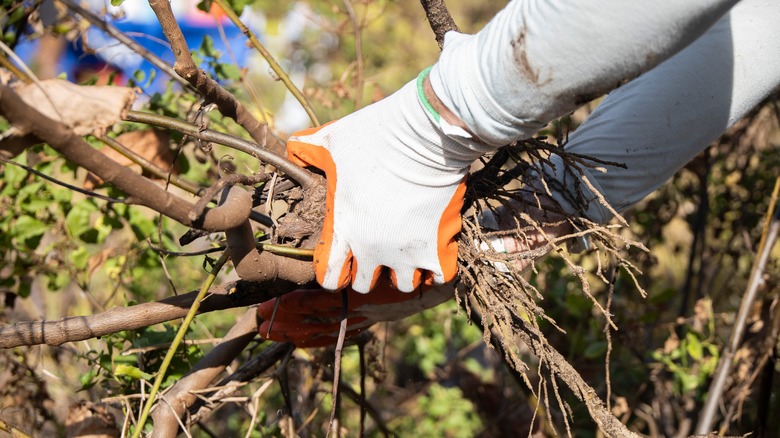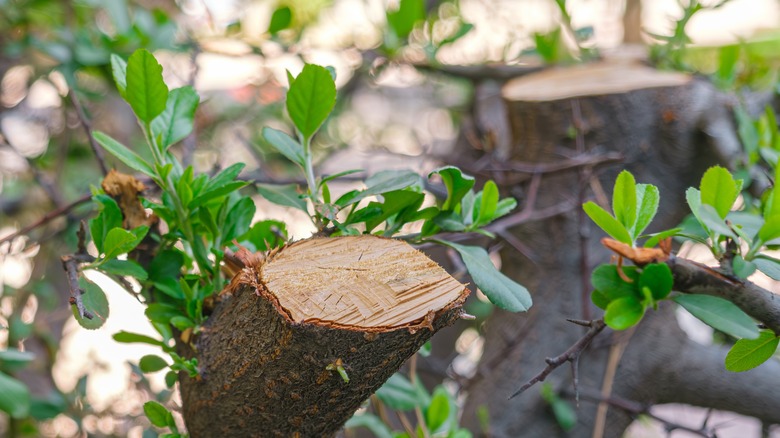Our Master Gardener's Tips For Dealing With Unwanted Bushes That Keep Growing Back
We may receive a commission on purchases made from links.
To say that the previous owner of my home and I have different tastes when it comes to bushes and planting locations would be an understatement. I've had to remove several large bushes that were too close to the house, others in awkward locations, and another that was dying. If you have a large bush in the middle of your yard, you may be able to wrap a chain around it and pull it out, roots and all, but most of the time that's not the case. That's why cutting the bush to the ground and keeping all new greenery cut back may be the easiest way to remove unwanted bushes. If necessary, you can also paint on herbicides to safely remove invasive plant species from your yard and garden.
I'm a big fan of working smarter, not harder, and this process uses the rules of nature to remove the bush by keeping the plant from performing photosynthesis. When the plant cannot use its leaves to create food to feed the roots, it slowly starves. Clearly, this process isn't the fastest way to get rid of a large, unwanted bush, but if it's planted too close to the house or is inaccessible to machinery, this method may be your best choice. For me, it was the easiest option since it doesn't require deep digging. You may also want to think twice before using herbicides in your yard and use extra caution if they're necessary.
Cut all stems to the ground
I first tested this process on nandina bushes that were planted too close to the house. The species I had were non-native and considered invasive, so clearly they had to go. These bushes were about 6 feet tall, so I used loppers to cut the stems as close to the ground as possible. After that, the stumps were a few inches tall. I spent the rest of the season cutting down all the stems that emerged from the roots with pruning shears or the weed eater. After one summer of being deprived of the ability to perform photosynthesis, the root system died and what remained of the stumps crumbled. A few minutes spent cutting down sprouts each week made the process of eliminating these large bushes pretty easy — and all I needed were basic gardening tools.
With that success behind me, I repeated this process on a mock orange bush, which I really liked but was planted in a terrible spot in my backyard and was too large to move. In this situation, since it was awkwardly placed in the middle of the yard, I was able to use a small saw to cut it to the ground. For the rest of the season, we just mowed over it and again, by the end of the season, it was a memory. Since then, I have repeated this process with a notoriously aggressive trumpet vine and an unwanted azalea.
Dealing with extra stubborn invasives
When dealing with extra difficult plants like invasive honeysuckle in your yard, this removal process may require an extra step. I always use extreme caution when dealing with herbicides, and there are safer ways to use brush killer than broadcast spraying. When you're fighting a battle against extra stubborn invasive species with woody stems and extensive root systems, employing the use of a heavy-duty herbicide may be your only option. In this case, I use the painting method.
Spraying an herbicide can damage surrounding plants, but "painting" it on an open wound only affects the plant you want to kill. The most efficient way I've found to do this is to use an envelope moistener, available on Amazon, filled with a heavy-duty brush killer and a few drops of acrylic paint to see which stumps have been treated. I cut each stem as close to the ground as possible and paint on the brush killer. Sometimes it takes a few treatments, but this process will kill even the most impossible invasives. You can do this any time the temperatures are above 40 degrees Fahrenheit (or whatever the product information states), but it's most effective in early fall. At this time, the days are still warm and sunny, but plants are preparing for winter by moving resources from leaves and stems to the roots. This means they will automatically draw the brush killer into their root system. Always follow product safety instructions when using herbicides.


